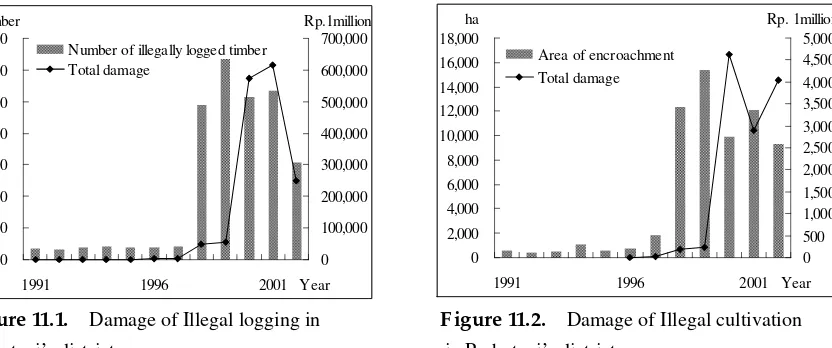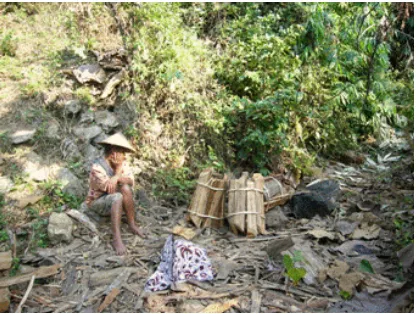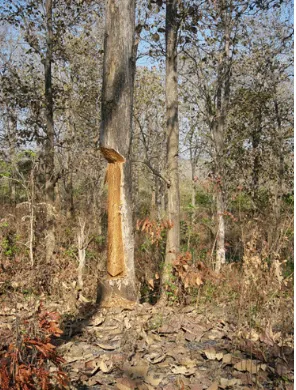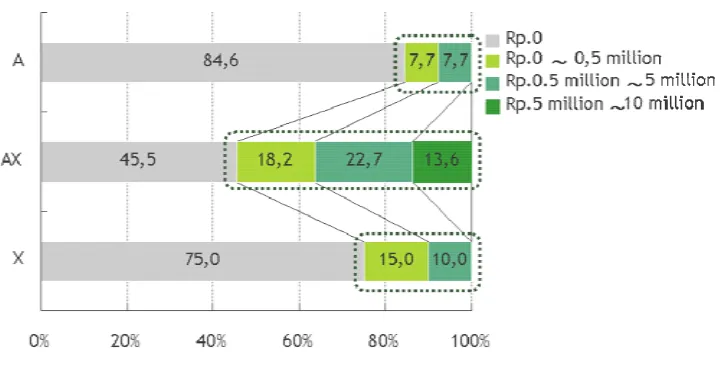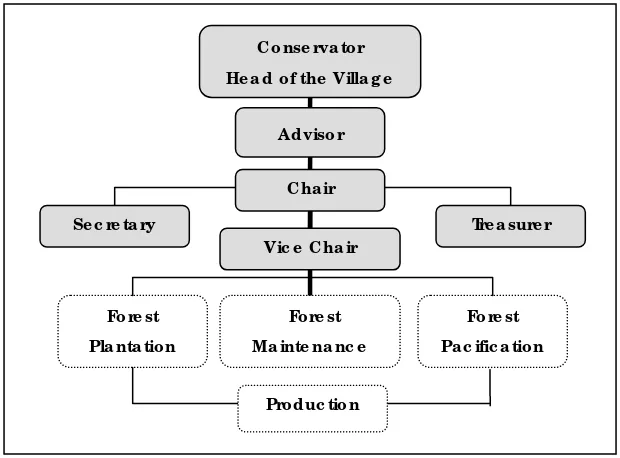right to intercrop in tumpangsari allotment for several years and grant cultivators right to obtain harvest from the allotment. In return, cultivators had to take care of seedlings. Due to tumpangsari system, Perhutani obtained cheap labor and cultivators obtain farmland without payment. According to Masuda (1986), there were two types of cultivators engaged tumpangsari in Central Java: one was professional forestry labor; another was farmer living in the surrounding village. This system was mutually beneficial, thus Perhutani’s forest management was comparatively stable.
0 500 1,000 1,500 2,000 2,500 3,000 3,500
1991 1996 2001 Year
Number 0 100,000 200,000 300,000 400,000 500,000 600,000 700,000 Rp.1million Number of illegally logged timber
Total damage 0 2,000 4,000 6,000 8,000 10,000 12,000 14,000 16,000 18,000
1991 1996 2001 Year
ha 0 500 1,000 1,500 2,000 2,500 3,000 3,500 4,000 4,500 5,000 Rp. 1million Area of encroachment
Total damage
F igure 11.1. Damage of Illegal logging in F igure 11.2. Damage of Illegal cultivation
fter 1998, however, many offensive activities, such as illegal logging, forest fire and illegal cultivation, Perhutani’s district in Perhutani’s district
Source: Perum Perhutani (1996), Perum Perhutani (2001), PT. Perhutani (2003)
A
[image:1.595.103.519.420.594.2]2. Methods
his study was carried out in July-September, 2003 and September, 2004. G village located in Japah sub
. Farmers in the teak forests
.1. Outline of G village
village is one of the enclaves commonly found in Kendung Utara and Kendung Selatan Mountains, which
This villag consisted of 1 sub-village (Dusun), 7 neighborhood associations (RT: Rukun Tetangga). The T
district, Blora district, Central Java province was selected as a study site. At the first year, the focus was on livelihood option of farmers who do not have permanent income source. The population excluding permanent employees was 336 households and 70 households (21%) were randomly sampled. The type of interview conducted was based on questionnaire about family structure, land possession, income, forest use, and etc. The second year focused on in depth interview based on questionnaire limiting the sample households to 42 households engaged in cultivation of state forests. Another village was also selected from the same sub district for a reference, and interviews to key informants were conducted. Unlike G village, which forms an enclave surrounded by teak forests, the locality of this S village is in between forests and plains.
3
3
G
have formed into the center of teak plantation. The People in this village depend on forest resources from the teak plantation, such as branch for fuel wood, leaves for wrapping food at ceremonies, medicinal plants, and other non-wood forest products (Figures. 11.3, 4, 5, 6, 7, 8 & 9).
e
F igure 11.3. Illegally logged over area in G village F igure 11.4. Pile of Illegally logged wood inside (August 2003). G village (September 2004).
F igure 11.5. & 11.6. Teak leaves used at a ritual of circumstance in G village (September 2004)
[image:3.595.85.293.107.264.2] [image:3.595.87.519.323.476.2] [image:3.595.87.292.511.667.2]F igure 11.9. Traditional medicine (jamu) made of medicinal plants (September 2003)
F igure 11.8. Kunci pepat(Kaempferia rotunda L.) (September 2003)
3.2. Changes in teak forest management
State forest in G village is included in KPH (Kesatuan Pemangkuan Hutan) Mantingan’s district. Forest in KPH Mantingan consists of Teak plantation forest. KPH Mantingan was one of the most damaged KPH by illegal logging. Therefore, around G village, tree illegally logged and person carrying illegally logged tree could be observed (Figures 11.10, 11, 12 & 13).
F igure 11.11. Seized wood by Perhutani (July 2003)
[image:4.595.71.221.97.285.2] [image:4.595.321.515.98.241.2] [image:4.595.284.495.465.620.2] [image:4.595.72.220.466.661.2]F igure 11.12. A man carrying teak wood F igure 11.13. Clearance of forestland (August 2004) (July 2004)
3.3. Land use and management in G village
[image:5.595.88.294.108.266.2] [image:5.595.312.520.109.264.2]A 41 3.6 60 62 6,653
AX 46 4.3 60 75 5,946
X 46 3.5 63 62 3,319
Source: Field survey (2003)
In type AX, more than 90% of households’ income from cultivated state forest account for less than 50% of total agricultural income and approximately half of households did not get income from C (Figure 11.15). In contrast, for almost all the households within type X, income from cultivated land in forest land account for 100%. To focus on conditions of harvest, 44.7% of households in type AX answered that they had poor harvests in CLF and only 25% of households of type X answered they had poor harvests in C (Figure 11.16). Therefore, type AX’s management of C was poor compared to type X’s management.
F igure 11.15. Percentages of income from FC of type AX
[image:7.595.89.499.215.297.2] [image:7.595.99.355.452.626.2]F igure 11.16. Conditions of harvest Source: Author’s field survey (2003)
Characteristic of economic activity could be estimated from non-agricultural income. Non-agricultural income can be obtained from sub-work, such as day laborer, middleman, peddler, etc. or sale of non timber forest products (NTFP). About 64% of the households of type AX had non-agricultural income from sub-works and about 40% of the households of type X had non-agricultural income from sub-works (Figure 11.17). About 55% of the households of type AX sold NTFP and about 25% of households of type X sold NTFP (Figure 11.18). Therefore, type AX’s economic activity was diverse and they got large income from non-agricultural works compared to the households of type X.
F igure 11.18. Income from NTFP Source: Author’s field survey (2003)
Table 11.4. Comparison of the changes in the types between 2003 and 2004
2003 2004
T ypes of lan d
m anagem en t N u m b er of h ouseh olds
T ypes of lan d m anagem en t
N um b er of h ou seholds (type of 2 003- type of 2004 )
A ’ 5 (A X -A :5 ) A X 22
A X ’ 1 9 (A X -A X : 16 , X -A X : 3 ) X 20
X ’ 1 8 (A X -X : 1 , X -X : 17)
Total 42 T otal 4 2
Source: Author’s field survey (2003, 2004)
Table 11.4 shows comparison of the changes in the types between 2003 and 2004. From 2003 to 2004, 5 households from type types AX stopped their activities in C. The reasons of stopping their activities were (number of households); termination of a contract with Perhutani (2), abandonment (too old to cultivate or because friend quitted) (2), pass on to other person (too old to cultivate) (1). In type X, there was one household who quitted cultivating in forestland because of boredom of cultivation (Figure 11.19).
F igure 11.19. Changes of types from 2003 to 2004
Source: Author’s field survey (2003, 2004)
[image:9.595.83.504.370.471.2] [image:9.595.84.293.605.705.2]aspect of income diversification. Thus, if they do not gain maximum benefit from the land, they abandon the C. X can be defined as indispensable type who envisions cultivation in the forestland as critical aspects of their livelihood strategy. They fully depend on the income that derives from the forestland. Therefore, forestland is inevitably indispensable.
Although all the types of households in the study site were able to access degraded land in the state forests and illegal cultivation, we should take appropriate management scheme for controlling different types of household. Improvement of tumpangsari can be one of the solutions that can be looked into by Perhutani. For types AX, it is necessary to control the engagement to tumpangsari, because they lack incentives for managing C and moreover C often fails to become an alternative income source for their livelihood. In contrast, for type X, it is necessary to shift their livelihood strategy from encroachment to the tumpangsari system. Hence, targeting potential types of farmers that can engage in tumpangsari system is crucial.
Fo re st
Pla nta tio n
Fo re st
Ma inte na nc e
Fo re st
Pa c ific a tio n
Pro duc tio n
F igure 11.20. Structure of Lembaga Masyarakat Desa Hutan Wana Lestari
LMDH is a institution to conduct PMDH, which consists of village apparatus and village members who have stakes to forest resources and are willing to participate in the program of PHBM (Fig 11.20). There are a conservator and an advisor superior to the chair of LMDH (Anonym., 2002). The conservator is served by the head of the village concerned. The program of LMDH complies with the activities provided by Perhutani, such as plantation, forest maintenance and guarding until production takes place. Perhutani facilitates and funds for the necessities until an LMDH is organized and starts their activities (Figure 20.21).
F igure 11.21. A ceremony to celebrate the first sharing of production (August, 2003)
The example to share the produce from thinning under PHBM is shown below: P = M × % (<25) × Total Production × I-1
P: share of LMDH from thinning
M: period of joint management of the forest concerned
[image:11.595.155.465.101.330.2] [image:11.595.179.394.464.625.2]In the case of Wana Lestari LMDH, they obtained the maximum of 25 %. If there are any damages caused by illegal activities such as logging, it reduces the share of LMDH.
4.3. The E ffects of PHBM Program
[image:12.595.70.380.312.350.2]According to the internal document Perhutani, damages caused by illegal logging in the areas under PHBM program, which consist of 52 villages, could be reduced after the implementation of PHBM (Table 11.5). Though it just compares the change of short period and PHBM program has just started in the villages cooperative to the acitivities of Perhutani, effectiveness of PHBM can be supposed from it can be conjectured. Whether it can be expanded to every village adjacent to valuable teak forests is seemed to one of the key issues for teak forest conservation and rehabilitation.
Table 11.5. Change of damages caused by Illegal logging in PHBM areas
Period Illegal logging
January – June 2002 5,518 m3
January – June 2003 2,089 m3
Source : KPH Blora (2003)
Acknowledgement
We wish to express our gratitude thanks to Unit I Central Java, KPH Blora, KPH Mantingan, BKPH Kalinanas, and residents in G and S villages.
Reference
Direksi Perum Perhutani. 1996. Statistik tahun 1991-1995. Direksi Perum Perhutani (Persero). Jakarta. Direksi Perum Perhutani. 2001. Statistik tahun 1996-2000. Direksi Perum Perhutani (Persero). Jakarta. Direksi PT. Perhutani (Persero). 2003. Statistik tahun 1998-2002. Direksi PT. Perhutani (Persero). Jakarta. Kartasubrata, Y. 1992. The history of sustainable forest management in Indonesia: the case of teak in Java.
Proceedings of an International Symposium on Sustainable Forest Management September 21-24, 1992. n.p. Yogyakarta.
G village. 2003. Profil desa. Unpublished.
Masuda, M. 1987. A study on the Socioeconomic Basis of Tumpangsari Afforestation System. Dissertation, Kyoto University. (in Japanese)
